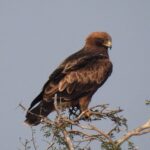The booted eagle (Hieraaetus pennatus) is a small to medium-sized bird of prey that is widely distributed in the Palearctic and southern Asia. These majestic birds are known for their elaborate aerial displays during courtship and their ability to thrive in a variety of habitats, from marshes to wooded areas. But how long do booted eagles live, and what factors influence their lifespan?
The Average Lifespan of Booted Eagles
The lifespan of the booted eagle is not well-studied, with limited information available on the longevity of these birds in the wild. However, based on the available data, the average lifespan of a booted eagle in captivity is around 12 to 15 years.
While the lifespan of booted eagles in the wild is generally believed to be a bit shorter than those in captivity, there have been reports of some individuals living over 20 years of age. This suggests that under the right conditions, booted eagles can potentially live for quite a long time.
Factors Influencing Booted Eagle Lifespan
 Image source: Booted eagle By Dr. Raju Kasambe
Image source: Booted eagle By Dr. Raju Kasambe
Several factors can influence the lifespan of booted eagles, both in captivity and in the wild. These include:
Diet and Nutrition
Booted eagles are carnivorous, feeding primarily on small mammals, birds, and reptiles. In captivity, their diet can be carefully controlled to ensure they receive the necessary nutrients for optimal health and longevity. In the wild, the availability and quality of their prey can have a significant impact on their lifespan.
Habitat and Environmental Conditions
Booted eagles are found in a variety of habitats, including marshes, scrublands, and wooded areas. The quality and stability of their habitat can greatly affect their lifespan, as factors such as habitat destruction, pollution, and climate change can all pose threats to their survival.
Predation and Human Interference
Larger eagles and humans are the primary predators of booted eagles. Habitat encroachment, hunting, and other human activities can also negatively impact their lifespan, particularly in areas with high human population density.
Breeding and Reproductive Success
The breeding and reproductive success of booted eagles can also influence their lifespan. Successful breeding and the rearing of healthy chicks can contribute to the longevity of these birds, as they are able to pass on their genes to the next generation.
Booted Eagle Conservation Efforts
Due to their relatively low population numbers and the threats they face, the booted eagle is considered a “rare” bird in Europe. Conservation efforts are underway to protect these magnificent birds and ensure their long-term survival.
These efforts include habitat preservation, monitoring of populations, and education campaigns to raise awareness about the importance of booted eagles and the need to protect them. By understanding the factors that influence their lifespan, we can better tailor our conservation strategies to support the long-term viability of booted eagle populations.
Conclusion
The booted eagle is a remarkable bird of prey with a lifespan that can span over 20 years in some cases. While the average lifespan of these birds in captivity is around 12 to 15 years, their longevity in the wild is influenced by a variety of factors, including diet, habitat, predation, and human interference.
By understanding the unique characteristics and needs of booted eagles, we can work to protect these birds and ensure that they continue to thrive in their natural habitats for generations to come.

